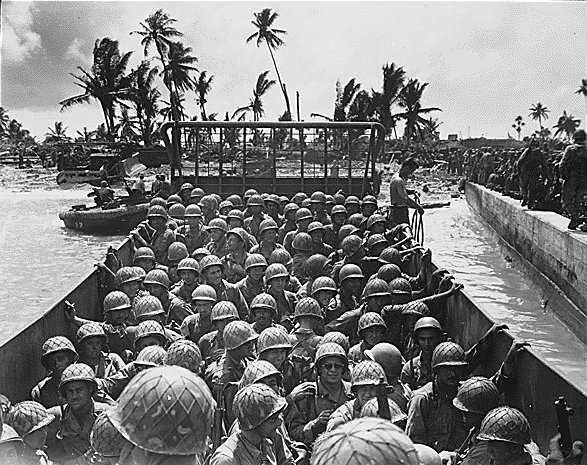The Battle of Kwajalein was fought between the United States and the Imperial Japanese Army from January 31 to February 4, 1944, on the Kwajalein Atoll, Marshall Islands. Kwajalein was the location of Japan’s outermost defensive perimeter and one the first targets of the United States in the campaign to take the Marshall Islands. By taking Kwajalein, the U.S. Navy would be able to advance through to the rest of the Marshall Islands, then the Philippines, and finally the Japanese home islands. After the challenges faced at The Battle of Tarawa, American military planners greatly improved on amphibious landing strategies, which would be implemented at Kwajalein and lead to a swift American victory.
U.S. forces had been bombarding Kwajalein from the air and sea two months before the actual attack began on January 31. The amphibious assault on the atoll thus began as 85,000 men and 300 warships approached. By February 1, the American 7th infantry (Army) had landed on Kwajalein. Meanwhile, the 4th Marine Division landed on two islands to the north, Roi and Namur. Roi and Namur were taken in a matter of days by the Marines, but Kwajalein took more time. Despite being greatly outnumbered, the Japanese forces on the atoll were determined to fight to the end. American soldiers attacked the Japanese garrison for three days until finally securing the island on February 4. The Americans experienced minimal losses, with only 142 soldiers killed. The Japanese, however, lost 4,300 at Kwajalein, and an additional 3,500 at Roi and Namur.
The victory at Kwajalein was accomplished ahead of the expectations of American General Chester Nimitz. This allowed for American forces to move forward with more battles in the Pacific quicker than they expected. The U.S. was now effectively in control of the Marshall Islands, giving them an important staging point for further amphibious operations in the Pacific. This victory also cut off supply lines to those islands which had been skipped as a part of the American island-hopping strategy, weakening Japanese-held islands and the Japanese position in the Pacific overall.
Suggested Reading:
History: The Battle of Kwajalein
Thought Co.: The Battle of Kwajalein
Samuel Marshall, Island Victory: The Battle of Kwajalein Atoll (Pickle Partners Publishing, 2015)








